江苏南部典型地区耕作层土壤及农作物中重金属评价
- 格式:pdf
- 大小:681.84 KB
- 文档页数:7
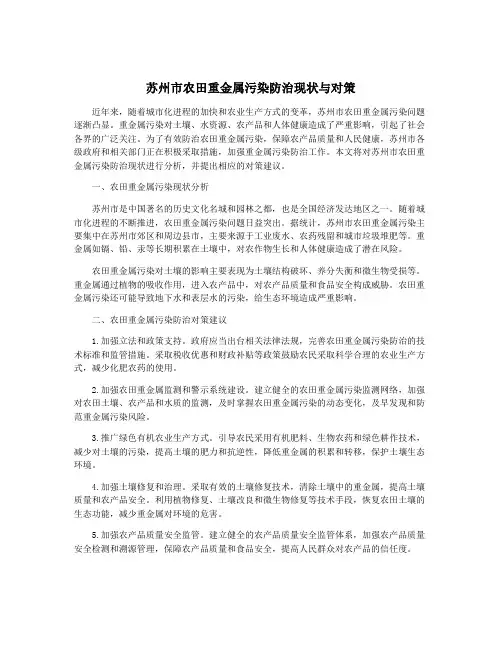
苏州市农田重金属污染防治现状与对策近年来,随着城市化进程的加快和农业生产方式的变革,苏州市农田重金属污染问题逐渐凸显。
重金属污染对土壤、水资源、农产品和人体健康造成了严重影响,引起了社会各界的广泛关注。
为了有效防治农田重金属污染,保障农产品质量和人民健康,苏州市各级政府和相关部门正在积极采取措施,加强重金属污染防治工作。
本文将对苏州市农田重金属污染防治现状进行分析,并提出相应的对策建议。
一、农田重金属污染现状分析苏州市是中国著名的历史文化名城和园林之都,也是全国经济发达地区之一。
随着城市化进程的不断推进,农田重金属污染问题日益突出。
据统计,苏州市农田重金属污染主要集中在苏州市郊区和周边县市,主要来源于工业废水、农药残留和城市垃圾堆肥等。
重金属如镉、铅、汞等长期积累在土壤中,对农作物生长和人体健康造成了潜在风险。
农田重金属污染对土壤的影响主要表现为土壤结构破坏、养分失衡和微生物受损等。
重金属通过植物的吸收作用,进入农产品中,对农产品质量和食品安全构成威胁。
农田重金属污染还可能导致地下水和表层水的污染,给生态环境造成严重影响。
二、农田重金属污染防治对策建议1.加强立法和政策支持。
政府应当出台相关法律法规,完善农田重金属污染防治的技术标准和监管措施。
采取税收优惠和财政补贴等政策鼓励农民采取科学合理的农业生产方式,减少化肥农药的使用。
2.加强农田重金属监测和警示系统建设。
建立健全的农田重金属污染监测网络,加强对农田土壤、农产品和水质的监测,及时掌握农田重金属污染的动态变化,及早发现和防范重金属污染风险。
3.推广绿色有机农业生产方式。
引导农民采用有机肥料、生物农药和绿色耕作技术,减少对土壤的污染,提高土壤的肥力和抗逆性,降低重金属的积累和转移,保护土壤生态环境。
4.加强土壤修复和治理。
采取有效的土壤修复技术,清除土壤中的重金属,提高土壤质量和农产品安全。
利用植物修复、土壤改良和微生物修复等技术手段,恢复农田土壤的生态功能,减少重金属对环境的危害。
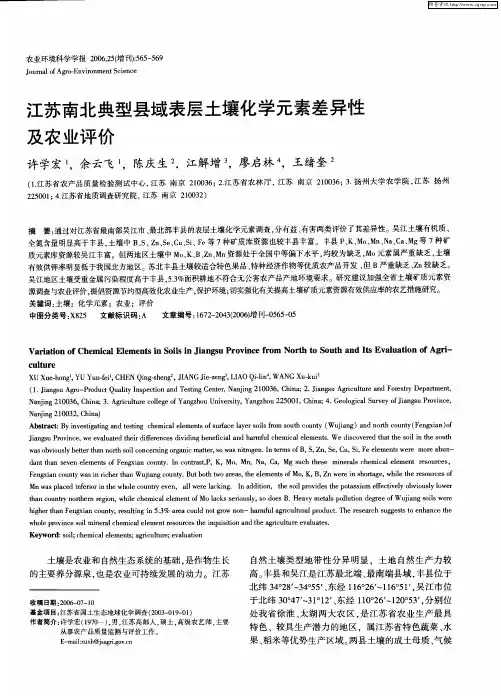
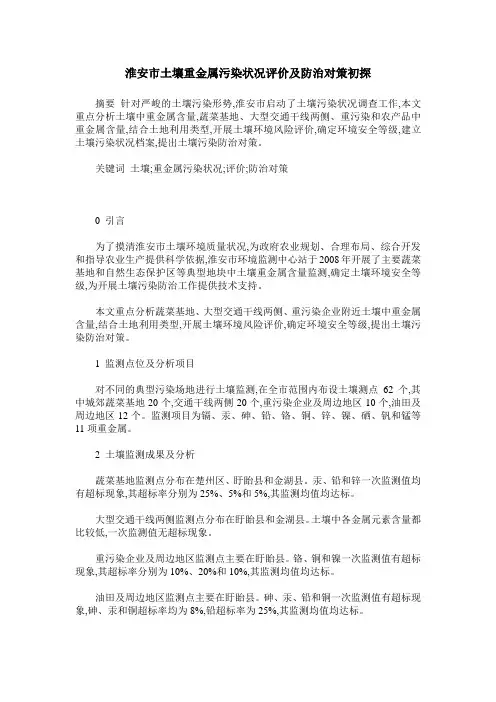
淮安市土壤重金属污染状况评价及防治对策初探摘要针对严峻的土壤污染形势,淮安市启动了土壤污染状况调查工作,本文重点分析土壤中重金属含量,蔬菜基地、大型交通干线两侧、重污染和农产品中重金属含量,结合土地利用类型,开展土壤环境风险评价,确定环境安全等级,建立土壤污染状况档案,提出土壤污染防治对策。
关键词土壤;重金属污染状况;评价;防治对策0 引言为了摸清淮安市土壤环境质量状况,为政府农业规划、合理布局、综合开发和指导农业生产提供科学依据,淮安市环境监测中心站于2008年开展了主要蔬菜基地和自然生态保护区等典型地块中土壤重金属含量监测,确定土壤环境安全等级,为开展土壤污染防治工作提供技术支持。
本文重点分析蔬菜基地、大型交通干线两侧、重污染企业附近土壤中重金属含量,结合土地利用类型,开展土壤环境风险评价,确定环境安全等级,提出土壤污染防治对策。
1 监测点位及分析项目对不同的典型污染场地进行土壤监测,在全市范围内布设土壤测点62个,其中城郊蔬菜基地20个,交通干线两侧20个,重污染企业及周边地区10个,油田及周边地区12个。
监测项目为镉、汞、砷、铅、铬、铜、锌、镍、硒、钒和锰等11项重金属。
2 土壤监测成果及分析蔬菜基地监测点分布在楚州区、盱眙县和金湖县。
汞、铅和锌一次监测值均有超标现象,其超标率分别为25%、5%和5%,其监测均值均达标。
大型交通干线两侧监测点分布在盱眙县和金湖县。
土壤中各金属元素含量都比较低,一次监测值无超标现象。
重污染企业及周边地区监测点主要在盱眙县。
铬、铜和镍一次监测值有超标现象,其超标率分别为10%、20%和10%,其监测均值均达标。
油田及周边地区监测点主要在盱眙县。
砷、汞、铅和铜一次监测值有超标现象,砷、汞和铜超标率均为8%,铅超标率为25%,其监测均值均达标。
监测结果表明,淮安市各种类型的土壤中汞、铅、铜、铬、镍和砷的一次监测值有超标现象,其监测均值均不超标。
蔬菜基地中汞含量明显高于其它典型地块,重污染企业及周边地区中镍含量明显高于其它典型地块,其它项目基本持平。
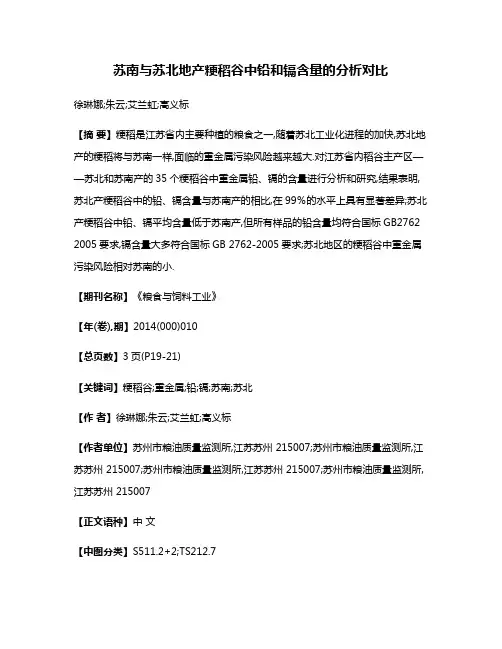
苏南与苏北地产粳稻谷中铅和镉含量的分析对比徐琳娜;朱云;艾兰虹;高义标【摘要】粳稻是江苏省内主要种植的粮食之一,随着苏北工业化进程的加快,苏北地产的粳稻将与苏南一样,面临的重金属污染风险越来越大.对江苏省内稻谷主产区——苏北和苏南产的35个粳稻谷中重金属铅、镉的含量进行分析和研究,结果表明,苏北产粳稻谷中的铅、镉含量与苏南产的相比,在99%的水平上具有显著差异;苏北产粳稻谷中铅、镉平均含量低于苏南产,但所有样品的铅含量均符合国标GB2762 2005要求,镉含量大多符合国标GB 2762-2005要求;苏北地区的粳稻谷中重金属污染风险相对苏南的小.【期刊名称】《粮食与饲料工业》【年(卷),期】2014(000)010【总页数】3页(P19-21)【关键词】粳稻谷;重金属;铅;镉;苏南;苏北【作者】徐琳娜;朱云;艾兰虹;高义标【作者单位】苏州市粮油质量监测所,江苏苏州 215007;苏州市粮油质量监测所,江苏苏州 215007;苏州市粮油质量监测所,江苏苏州 215007;苏州市粮油质量监测所,江苏苏州 215007【正文语种】中文【中图分类】S511.2+2;TS212.720世纪以来,随着人口数量的大幅增加,工业的快速发展,农用化学品的大量使用及城市污水的排放,农田、土壤的重金属污染日趋严重。
水稻作为我国最重要的粮食作物,目前其总产、种植面积和单产分居世界的第一、第二和第七位[1]。
稻田的重金属污染不仅导致水稻生长发育受阻,产量下降,更为严重的是重金属在水稻体内大量蓄积,并通过食物链传递,对人和动物的生命和健康构成了严重威胁,直接影响我国的粮食安全[2]。
江苏省是我国经济发展迅速、土地利用变化和环境演变强烈的省份。
苏南局部地区在工业化的进程中,土壤环境的重金属污染加剧,其食物安全风险十分严峻。
随着苏南产业链的转移,苏北地区的工业在飞速发展的同时,也面临着日趋严重的环境污染问题。
粳米是江苏省居民的主要消费食品,苏南和苏北又是整个江苏省最为重要的粳稻谷产区和人口密集居住区。
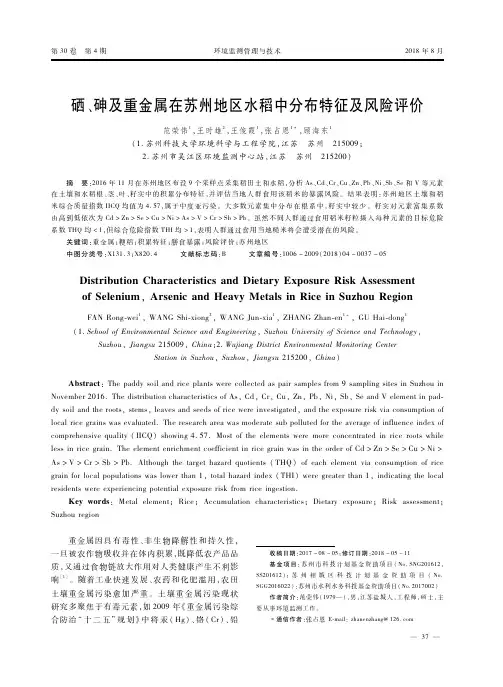
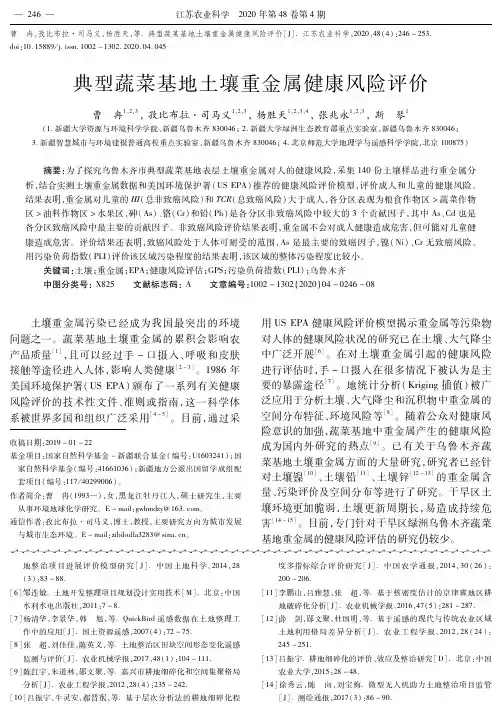
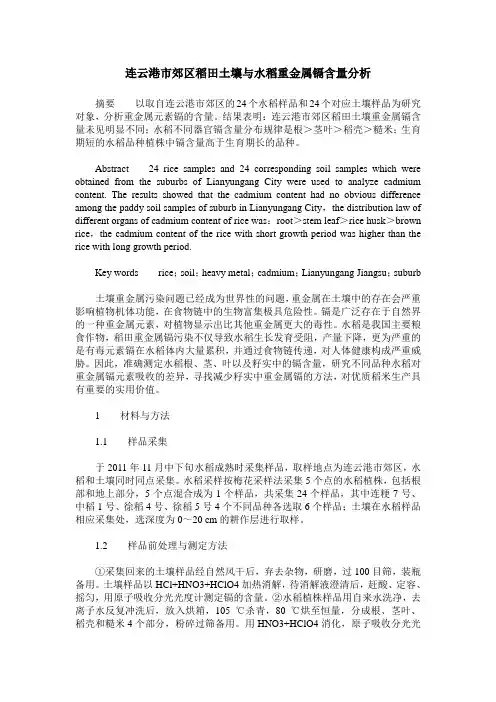
连云港市郊区稻田土壤与水稻重金属镉含量分析摘要以取自连云港市郊区的24个水稻样品和24个对应土壤样品为研究对象,分析重金属元素镉的含量。
结果表明:连云港市郊区稻田土壤重金属镉含量未见明显不同;水稻不同器官镉含量分布规律是根>茎叶>稻壳>糙米;生育期短的水稻品种植株中镉含量高于生育期长的品种。
Abstract 24 rice samples and 24 corresponding soil samples which were obtained from the suburbs of Lianyungang City were used to analyze cadmium content. The results showed that the cadmium content had no obvious difference among the paddy soil samples of suburb in Lianyungang City,the distribution law of different organs of cadmium content of rice was:root>stem leaf>rice husk>brown rice,the cadmium content of the rice with short growth period was higher than the rice with long growth period.Key words rice;soil;heavy metal;cadmium;Lianyungang Jiangsu;suburb土壤重金属污染问题已经成为世界性的问题,重金属在土壤中的存在会严重影响植物机体功能,在食物链中的生物富集极具危险性。
镉是广泛存在于自然界的一种重金属元素,对植物显示出比其他重金属更大的毒性。
水稻是我国主要粮食作物,稻田重金属镉污染不仅导致水稻生长发育受阻,产量下降,更为严重的是有毒元素镉在水稻体内大量累积,并通过食物链传递,对人体健康构成严重威胁。


江苏省土壤重金属Pb空间分析摘要本文通过对已有的江苏省各个地区土壤重金属Pb研究的文献进行一个总的整理分析、比较和归纳,并通过GIS的应用展现出江苏整体的土壤重金属Pb的空间分布和污染状况。
对整个江苏以及江苏的部分县市土壤重金属Pb的污染状况和含量都进行了一系列的细致分析和总结。
结果表明整个江苏省土壤重金属Pb的污染状况受人类影响较大,其Pb空间分布跟经济分布有关。
苏南地区土壤Pb污染相对苏中和苏北地区比较严重,特别是苏州和无锡,表层土Pb平均含量是江苏省最高,分别是34.3mg/kg、34.2mg/kg;南通表层土Pb平均含量是江苏省最低的,其值是21.5mg/kg。
整个江苏省区域土壤Pb 平均含量未超过世界土壤中值35mg/kg。
关键词:土壤;重金属;污染;Pb;GIS;江苏Jiangsu Province, spatial analysis of heavy metal PbAbstractBased on the existing soil in various regions of Jiangsu Province of the literature Pb, a total analyzed, compared and summarized and demonstrated through the application of GIS in Jiangsu overall spatial distribution of soil Pb, and pollution. On the part of Jiangsu Province, cities and counties in Jiangsu and heavy metal contents of Pb pollution situation and have carried out a series of detailed analysis and summary. The results show that the entire Jiangsu province the pollution of heavy metal Pb influenced by humans, the spatial distribution of Pb with the distribution of the economy. Pb contaminated soil in South Central and North areas relatively more serious, especially in Suzhou and Wuxi, the average content of Pb in surface soil is the highest in Jiangsu Province, respectively 34.3mg/kg, 34.2mg/kg; Nantong average content of Pb in surface soil is the lowest in Jiangsu Province, and its value is 21.5mg/kg. The Jiangsu Province average concentration of soil Pb in soil did not exceed the value of the world 35mg/kg.Key words: soil; heavy metals; pollution; Pb; GIS; Jiangsu目录摘要 (1)ABSTRACT (1)1 前言 (4)1研究背景和意义 (4)2 文献综述 (5)2 数据来源和方法 (9)3 结果 (9)3.1 江苏 (10)3.1.1 省辖市土壤Pb含量分布 (10)3.1.2 省蔬菜基地土壤Pb含量分布 (12)3.1.3 省农用地土壤Pb含量分布 (14)3.1.4 省不同地貌土壤Pb含量分布 (16)3.2 南京 (17)3.3 苏州 (18)3.4 徐州 (21)3.5 南通 (23)3.6 常州 (25)3.7 扬州 (26)3.8 连云港 (27)3.9 无锡 (30)3.10 盐城 (30)3.11 淮安 (30)4 结果讨论 (31)5 致谢 (31)6参考文献 (31)1 前言1研究背景和意义:江苏位于长江、淮河下游,黄海、东海之滨,北接山东,西连安徽、河南,东南与上海、浙江接壤,是长江三角洲地区的重要组成部分,介于东经116°18′-121°57′,北纬30°45′-35°20′之间。
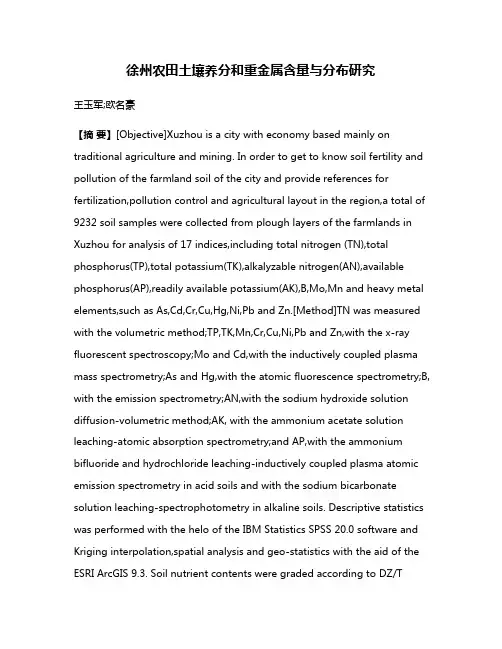
徐州农田土壤养分和重金属含量与分布研究王玉军;欧名豪【摘要】[Objective]Xuzhou is a city with economy based mainly on traditional agriculture and mining. In order to get to know soil fertility and pollution of the farmland soil of the city and provide references for fertilization,pollution control and agricultural layout in the region,a total of 9232 soil samples were collected from plough layers of the farmlands in Xuzhou for analysis of 17 indices,including total nitrogen (TN),total phosphorus(TP),total potassium(TK),alkalyzable nitrogen(AN),available phosphorus(AP),readily available potassium(AK),B,Mo,Mn and heavy metal elements,such as As,Cd,Cr,Cu,Hg,Ni,Pb and Zn.[Method]TN was measured with the volumetric method;TP,TK,Mn,Cr,Cu,Ni,Pb and Zn,with the x-ray fluorescent spectroscopy;Mo and Cd,with the inductively coupled plasma mass spectrometry;As and Hg,with the atomic fluorescence spectrometry;B, with the emission spectrometry;AN,with the sodium hydroxide solution diffusion-volumetric method;AK, with the ammonium acetate solution leaching-atomic absorption spectrometry;and AP,with the ammonium bifluoride and hydrochloride leaching-inductively coupled plasma atomic emission spectrometry in acid soils and with the sodium bicarbonate solution leaching-spectrophotometry in alkaline soils. Descriptive statistics was performed with the helo of the IBM Statistics SPSS 20.0 software and Kriging interpolation,spatial analysis and geo-statistics with the aid of the ESRI ArcGIS 9.3. Soil nutrient contents were graded according to DZ/T0295-2016 and soil heavy metal contents,using the Nemerowindex.[Result]The descriptive statistics showed that the average contents of soil nutrients in Xuzhou were higher than those in Jiangsu and China,while the average contents of heavy metal elements were higher than those in Jiangsu and China, and than the background values of Xuzhou,too. The variation coefficients of AP,AK,Mo and Hg were higher than those of the other elements,which indicated high variability between soil samples. Over 80% of the farmlands were rated as moderate or higher in soil nutrient content,while over 99% of the farmlands were sorted into the category of clean or safe soils. Farmlands lightly polluted by As,Cd,Cu or Ni were very limited in area. The higher soil nutrient contents may be attributed to long-term farming cultivation and application of organicmanure,meanwhile,the higher heavy metal contents may come from mining and smelting of coal,iron and copper and relevant industries,as well,like thermal power. All the soil indices exhibited significant characteristics in spatial distribution and their spatial correlations with soil types and farmland types. Spatial distributions of TN,TP,TK,AN,AP and AK contents were apparently quite similar,but those of AN,AP and AK varied sharply,while those of B,Mo and Mn did even more. The distribution of heavy metal elements in farmland soils exhibited a declining trend from north to south. The sharp spatial variation of soils in composition was mainly related to soil type and farmland type. Soils derived from lacustrine sediments were higher than those from hill slope sediments and from river alluvium in nutrient content and heavy metals content,and paddy soilshigher than dryland soils and garden soils,too. Besides,landform was also an important influencing factor.[Conclusion]The average contents of soil nutrients and heavy metal elements in the farmlands of Xuzhou are generally higher than those of Jiangsu and China and than the background values,too. Over 80% of the farmland soils in Xuzhou can be rated moderate or higher in nutrient content level while merely less than 1% is polluted by heavy metal elements. The main factors influencing contents and distribution of soil nutrients and heavy metal elements include soil type,soil parent material,landform tillage,fertilization,as well as mining and industries.%测定分析了江苏省徐州市9232个农田土壤耕层样品的养分含量和重金属含量,并综合运用GIS空间分析与统计方法研究了土壤大量养分(全氮(TN)、全磷(TP)、全钾(TK)、碱解氮(AN)、有效磷(AP)和速效钾(AK))、微量养分全量(硼(B)、锰(Mn)、钼(Mo))和重金属全量(砷(As)、镉(Cd)、铬(Cr)、铜(Cu)、汞(Hg)、镍(Ni)、铅(Pb)、锌(Zn))的统计特征、空间分布特征及其在不同土壤类型和农田类型中的分布差异.结果表明,徐州农田耕层土壤中的养分和重金属元素含量总体高于江苏和全国平均值,养分含量达中等水平以上的面积比例超过80%,99%以上的农田土壤重金属元素含量为清洁或尚清洁.养分含量偏高与徐州农田耕作程度较高有关,重金属元素含量超标与工矿业生产有关.养分和重金属元素含量在空间分布上有较大分异,不同成因的土壤类型和不同农田类型的养分和重金属元素含量差异明显.【期刊名称】《土壤学报》【年(卷),期】2017(054)006【总页数】13页(P1438-1450)【关键词】土壤养分;重金属元素;耕层土壤;空间分布;土壤类型;农田类型【作者】王玉军;欧名豪【作者单位】南京农业大学公共管理学院,南京 210095;江苏省地质调查研究院,国土资源部地裂缝地质灾害重点实验室,南京 210018;南京农业大学公共管理学院,南京 210095【正文语种】中文【中图分类】P632;P596土壤是农作物生长的载体和最基本的农业生产资料[1]。
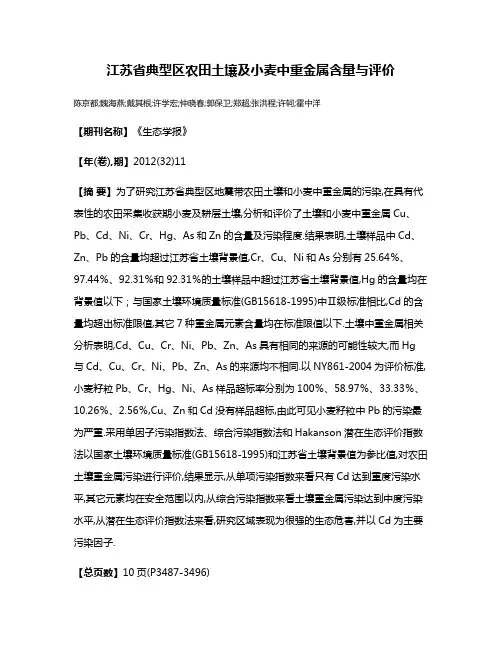
江苏省典型区农田土壤及小麦中重金属含量与评价陈京都;魏海燕;戴其根;许学宏;仲晓春;郭保卫;郑超;张洪程;许轲;霍中洋【期刊名称】《生态学报》【年(卷),期】2012(32)11【摘要】为了研究江苏省典型区地震带农田土壤和小麦中重金属的污染,在具有代表性的农田采集收获期小麦及耕层土壤,分析和评价了土壤和小麦中重金属Cu、Pb、Cd、Ni、Cr、Hg、As和Zn的含量及污染程度.结果表明,土壤样品中Cd、Zn、Pb的含量均超过江苏省土壤背景值,Cr、Cu、Ni和As分别有25.64%、97.44%、92.31%和92.31%的土壤样品中超过江苏省土壤背景值,Hg的含量均在背景值以下;与国家土壤环境质量标准(GB15618-1995)中Ⅱ级标准相比,Cd的含量均超出标准限值,其它7种重金属元素含量均在标准限值以下.土壤中重金属相关分析表明,Cd、Cu、Cr、Ni、Pb、Zn、As具有相同的来源的可能性较大,而Hg 与Cd、Cu、Cr、Ni、Pb、Zn、As的来源均不相同.以NY861-2004为评价标准,小麦籽粒Pb、Cr、Hg、Ni、As样品超标率分别为100%、58.97%、33.33%、10.26%、2.56%,Cu、Zn和Cd没有样品超标,由此可见小麦籽粒中Pb的污染最为严重.采用单因子污染指数法、综合污染指数法和Hakanson潜在生态评价指数法以国家土壤环境质量标准(GB15618-1995)和江苏省土壤背景值为参比值,对农田土壤重金属污染进行评价,结果显示,从单项污染指数来看只有Cd达到重度污染水平,其它元素均在安全范围以内,从综合污染指数来看土壤重金属污染达到中度污染水平,从潜在生态评价指数法来看,研究区域表现为很强的生态危害,并以Cd为主要污染因子.【总页数】10页(P3487-3496)【作者】陈京都;魏海燕;戴其根;许学宏;仲晓春;郭保卫;郑超;张洪程;许轲;霍中洋【作者单位】扬州大学江苏省作物遗传生理重点实验室/农业部长江流域稻作技术创新中心,扬州225009;扬州大学江苏省作物遗传生理重点实验室/农业部长江流域稻作技术创新中心,扬州225009;扬州大学江苏省作物遗传生理重点实验室/农业部长江流域稻作技术创新中心,扬州225009;江苏省农产品质量检验测试中心,南京210036;扬州大学江苏省作物遗传生理重点实验室/农业部长江流域稻作技术创新中心,扬州225009;扬州大学江苏省作物遗传生理重点实验室/农业部长江流域稻作技术创新中心,扬州225009;扬州大学江苏省作物遗传生理重点实验室/农业部长江流域稻作技术创新中心,扬州225009;扬州大学江苏省作物遗传生理重点实验室/农业部长江流域稻作技术创新中心,扬州225009;扬州大学江苏省作物遗传生理重点实验室/农业部长江流域稻作技术创新中心,扬州225009;扬州大学江苏省作物遗传生理重点实验室/农业部长江流域稻作技术创新中心,扬州225009【正文语种】中文【相关文献】1.典型黑土区农田土壤与玉米中重金属含量研究 [J], 张继舟;栾志慧;张弘强;曹宏杰;王宏韬2.岳阳市典型农田土壤重金属含量及生态风险评价 [J], 喻方琴;熊剑;黄卫;胡琦;彭娴;朱丹丹3.广西典型岩溶区重金属高背景区农田土壤生态风险综合评价 [J], 赵辛金;吴天生;钟晓宇;岳国辉;卢炳科;陈彪;李杰4.武汉市黄陂区农田土壤重金属含量及其污染风险评价 [J], 王素萍;陈钢;李培根;张贵友;杜雷;黄翔;洪娟;姜利;练志诚;张利红;叶莉霞5.典型农业区农田土壤重金属潜在生态风险评价 [J], 贾琳;杨林生;欧阳竹;王五一;李海蓉;李永华;虞江萍因版权原因,仅展示原文概要,查看原文内容请购买。
江苏某典型蔬菜基地土壤重金属污染调查摘要文章对江苏某典型蔬菜基地土壤中砷(As)、镉(Cd)、铬(Cr)、铜(Cu)、汞(Hg)、镍(Ni))、铅(Pb)和锌(Zn)8种重金属含量进行了调查分析,研究表明:中酸性土覆盖区是主要的重金属污染区。
关键词:土壤;重金属;风险评价;污染土壤重金属污染已经成为一个世界性的环境问题[1],许多国家均出现了蔬菜基地土壤重金属累积和超标问题[2]。
本文在分析中国现有最新土壤环境质量评价等众多标准的基础上,以江苏某芦蒿生产基地为典型区进行了大比例尺高密度的样品采集,对表层土壤中As、Cd、Cr、Cu、Hg、Ni、Pb、Zn八种重金属元素,以《土壤环境质量农用地土壤污染风险管控标准》筛选值(GB15618 - 2018)为基准,对区域土壤重金属污染采用单因子指数评价法评价。
1 材料与方法1.1 样品采集与分析研究样品点位在2017年遥感影像上采用网格化(500 m × 250 m)布设,取样深度均为0~20cm,取样时间为2017年10月。
外业采用手持GPS定位,坐标系为WGS - 84,高斯-克吕格投影,中央经线117度,6度带。
采样方法为梅花五点法,在布设的采样点上,以GPS定位点为中心,距离20~30米范围内向四周辐射确定4个分样点,等份组合成一个混合样,混合样品重量约为2 kg。
剔除土壤样品与金属采样器接触的部分后,放入布袋中保存,运回实验室进行预处理。
土壤样品首先自然风干,剔除样品中植物根系、残渣及可见侵入体,用木制工具碾碎。
先过2 mm尼龙筛去除土壤中较大的碎屑、石块等杂物,过筛后的样品充分搅拌、混合直至均匀,四分法取一部分用于pH测试;剩余一部分继续在玛瑙研钵中研磨至<0.074 mm,用于测定重金属元素含量。
土样的测定分析所用试剂、标准溶液配置以及仪器工作参数均遵循相关技术要求规范。
利用原子荧光光谱法(HG - AFS)测定As和Hg含量,利用石墨炉原子吸收光谱法(GF - AAS)分析Cd、Pb含量;利用电感耦合等离子体质谱(ICP - MS)测定Cr、Cu、Ni、和Zn含量,样品分析质量水平由重复性检验的方式监控。
第24卷第5期农业工程学报V ol.24 No.578 2008年5月 Transactions of the CSAE May 2008基于分等样地的江苏典型区农用地土壤重金属污染研究周生路1,廖富强1,2,吴绍华1,任奎1,张红富1,李志1 (1.南京大学地理与海洋科学学院,南京 210093; 2.江西师范大学地理与环境学院,南昌 330022)摘 要:在江苏农用地分等东台、六合-八卦洲、宜兴、昆山4个典型区样地进行土壤样品采集、测试分析与评价的基础上,采用GIS软件Sufer8.0,通过Kriging插值研究了农用地土壤重金属污染及其空间分布特征与规律。
结果表明:1)东台农用地土壤重金属污染总体处于安全水平,六合-八卦洲有一定的污染,但总体尚好,宜兴则面临更高程度的污染危险,而昆山部分已经达到轻度污染,这种分布格局与经济发展形式及水平具有很强的相关性;2)4个典型区内部农用地土壤重金属具有各自的空间分布规律及其相应的形成因素;3)通过在分等标准样地土壤样品采集、测试分析,能够较好地揭示不同类型地区农用地重金属污染状况,从而为农用地环境质量管理和农业清洁生产等提供参考。
关键词:农用地;分等样地;环境质量;重金属污染;江苏省中图分类号:X53 文献标识码:A 文章编号:1002-6819(2008)-5-0078-06周生路,廖富强,吴绍华,等. 基于分等样地的江苏典型区农用地土壤重金属污染研究[J].农业工程学报,2008,24(5):78-83.Zhou Shenglu, Liao Fuqiang, Wu Shaohua, et al. Farmland soil heavy metal pollution in typical areas of Jiangsu Province based on classification sample plots[J]. Transactions of the CSAE, 2008,24(5):78-83.(in Chinese with English abstract)0引 言土壤作为自然圈层之一,是大气、水体、生物中物质迁移、滞留与沉积的重要场所,也是净化环境的过滤器。
江苏省内农田土壤重金属污染状况及其修复研究随着工业化进程的推进和农业生产的发展,农田土壤重金属污染问题逐渐成为全球范围内的环境和农业生产的重要问题。
江苏省作为中国的经济强省之一,也面临着类似的土壤重金属污染问题。
本文将围绕江苏省农田土壤重金属污染的状况及其修复研究展开探讨。
首先,需要了解江苏省农田土壤重金属污染的现状。
根据相关调查报告,江苏省内部分地区的农田土壤中存在着镉、铅、汞等重金属元素的超标问题。
这主要源于长期以来工业废弃物的不当处理和使用农药、化肥等农业生产活动。
这些重金属元素会通过气态、液态、固态等形式进入土壤,并随着农产品的生长和农田的利用逐渐积累,对农作物生长和人体健康构成潜在风险。
其次,针对江苏省农田土壤重金属污染问题的修复研究已经取得了一定的进展。
主要研究方法包括物理方法、化学方法和生物方法。
物理方法主要利用重金属元素的物理性质,如迁移、转化和迁移能力的差异,通过土壤修复技术来降低土壤中重金属的含量,常见的修复技术有堆肥堆添加材料和土壤覆盖等。
化学方法主要通过添加化学剂,如石灰土、磷酸盐和有机物等来改变土壤环境,降低重金属元素的有效性和迁移能力。
生物方法是通过植物和微生物等生物体的生理特性,将土壤中的重金属元素吸附、转化和蓄积,常见的技术有植物修复和微生物修复等。
在江苏省的实际应用中,植物修复技术是被广泛采用的一种修复方法。
通过筛选适应江苏省生态环境的植物物种,引入到受重金属污染的农田土壤中,利用植物的吸收、承载和转运特性,将重金属元素从土壤转移到植物体内,并通过生物吸附和沉积的方式修复土壤。
此外,植物修复还能改善土壤的肥力和结构特性,提升农作物的产量和质量。
另外,微生物修复技术也在江苏省内得到了一定的应用。
微生物具有高效、经济和可持续的特点,能够降解重金属元素和转化有害物质,为土壤修复提供了一种新思路。
研究表明,适当添加合适的微生物菌剂可以显著降低土壤中重金属的浓度,改善土壤环境。
苏州市农田重金属污染防治现状与对策
苏州市作为江苏省的一个重要城市,农业在整个市经济中占有重要地位。
由于长期以来的工业污染和农业化肥农药的过度使用,苏州市农田重金属污染问题日益严重,对农业生产和人民健康造成了威胁。
苏州市农田重金属污染主要包括铅、镉、汞等重金属元素的超标问题。
这些重金属元素在农田土壤中的积累,会进入农作物、水源和食物链,最终对人体健康产生不良影响。
长期接触重金属污染的人们容易出现中毒症状,如贫血、神经系统损伤、肝肾损害等。
针对苏州市农田重金属污染问题,应采取以下对策:
1. 严格控制工业废水排放。
加强对工业企业的监管,确保废水排放符合国家标准。
对违法排放的企业要进行罚款或关闭,以减少对农田的污染。
2. 推广无公害农业技术。
引导农民使用少量或不使用农药、化肥,推广有机农业和生态农业,减少对土壤和农作物的污染风险。
3.加强农田重金属污染治理技术研究。
加强科研力量,研发农田重金属污染治理技术和方法。
通过土壤修复、植物修复等手段,减少污染土壤中重金属元素的积累。
4.建立农产品质量监测体系。
加强对农产品质量的检测,保障市场上农产品的安全,避免农产品被污染重金属。
5. 加强企业社会责任和政府监管。
企业应积极承担环境责任,加强自身的环保设施建设和管理。
政府应建立健全相关法律法规,在重金属污染防治方面加强监管和执法力度。
苏州市的农田重金属污染问题需要全社会的共同努力来解决。
只有加强工业废水排放控制、推广绿色农业技术、加强科研和监管,才能从根本上改善农田重金属污染问题,并确保农产品的质量和人民身体健康。
苏州市农田重金属污染防治现状与对策【摘要】目前,苏州市农田重金属污染问题日益严重,给农田生态环境和农产品安全带来了巨大挑战。
本文首先介绍了苏州市农田重金属污染的现状,包括主要的污染源和受污染面积。
然后分析了重金属污染对农田的影响,包括土壤质量下降、农产品安全风险增加等问题。
接着提出了针对苏州市农田重金属污染的防治措施建议,包括加强农田环境监测和修复、推进绿色农业发展等方面的措施。
同时强调了政府监管的重要角色和科技创新在重金属污染防治中的应用。
最后总结回顾了本文的主要观点,并展望了未来的发展方向。
为了保障农田生态环境和农产品安全,建议政府部门加大投入和监管力度,推动科技创新与绿色发展相结合,共同应对苏州市农田重金属污染挑战。
【关键词】苏州市、农田、重金属污染、防治、政府监管、科技创新、影响、建议、总结、展望、对策、环境保护、土壤污染、农业发展。
1. 引言1.1 背景介绍苏州市位于中国东部,是一座历史悠久、风景如画的城市,拥有优美的自然环境和丰富的农业资源。
随着城市化进程的加快和工业化发展的不断扩张,苏州市农田面临着严重的重金属污染问题。
近年来,随着城市工业不断发展壮大,大量的重金属废水和废气排放进入农田土壤和农作物中,严重危害了农田生态环境和人们健康安全。
苏州市农田重金属污染已成为严峻挑战,迫切需要采取有效措施加以解决。
重金属污染不仅会降低农田土壤质量,影响作物生长,还会导致农产品质量下降,对人体健康造成潜在的风险。
加强对苏州市农田重金属污染的监测和防治工作,是当前亟待解决的重要问题。
本文旨在探讨苏州市农田重金属污染的现状,分析其对农田的影响,并提出相应的防治措施,以期为解决该问题提供一定参考。
1.2 问题提出苏州市农田重金属污染问题不容忽视。
随着城市化进程的加快和工业化水平的提升,农田重金属污染已成为一个严重的环境问题。
大量的工业废水、废渣、废气排放进入农田,导致土壤中重金属含量超标,严重影响了农田生产安全和食品安全。
无锡市典型农田土壤重金属污染现状评价作者:周赟来源:《城市地理》2015年第09期摘要:为了解无锡市农田重金属污染现状,选取典型的3个粮食产区和2个蔬菜基地针对铬、砷、镉、铅、铜、锌、镍、汞等项目进行调查与分析,在此基础上采用单因子污染指数法和内罗梅综合污染指数法进行评价。
结果表明,单项污染程度均为无污染,综合污染等级均为清洁,土壤污染分担率总镍最大,总铅最小。
关键词:无锡;农田;重金属一、调查区域基本资料1、粮食产区(1)江阴市徐霞客镇阳庄村万顷良田:位于徐霞客镇马镇社区,面积约2000亩,引进开发良种及高新技术,开展秸秆综合利用,实现规模、稳产、优质、安全、高效的产业目标和绿色、清洁、有序、优美的环境目标。
万顷良田只种植一季水稻,冬季农田闲置,春季种植紫云英作为有机绿肥,不施用化肥、农药,旨在产出优质的有机米。
(2)锡山区东港镇东南村太湖水稻示范园:位于东港镇,面积约300多公顷。
园区以水稻或水稻种植小麦轮种为主,经过土地整治后,土地高低平整,有利于推广机械化和保证灌溉效果,全面建设灌溉系统,精确用水,保证稳定丰收。
示范园在立项之初便是以提高主要粮食作物水稻(轮种小麦)的单位产量和质量为出发点和目标,是典型的水稻大田集中经营。
(3)无锡惠山都市农业园(一期):总规模为5400亩,是一个集生产、生态、高效、集约于一体的现代稻作主题园区。
一期工程位于玉祁街道蓉东村,土壤以乌泥土、乌散土为主,主要作物种类为水稻,有机肥投入较少,磷、钾及中微量元素肥料施用比例偏低。
2、蔬菜基地(1)江阴市滕国俊阳庄菜业专业合作社蔬菜种植基地:位于徐霞客镇马镇社区,种植面积约650亩,主要有叶菜类、根茎类、果菜类、菌类等几大类,共70余个品种。
以白屈港河水为灌溉水源,根据蔬菜种类的不同采用微喷、滴灌、喷灌等灌溉形式。
肥料主要为有机肥和复合肥两种,其中有机肥为作物种植之前以鸡粪、菜饼、豆饼等作为土壤基肥。
(2)宜兴市周铁镇洋溪村蔬菜种植基地:位于具有“鱼米之乡”美称的太湖之滨,洋溪由原洋溪、旧渎、张家、向阳、横柑合并而成,属太湖地区一级保护级别,产业以蔬菜种植为主,无工业污染。